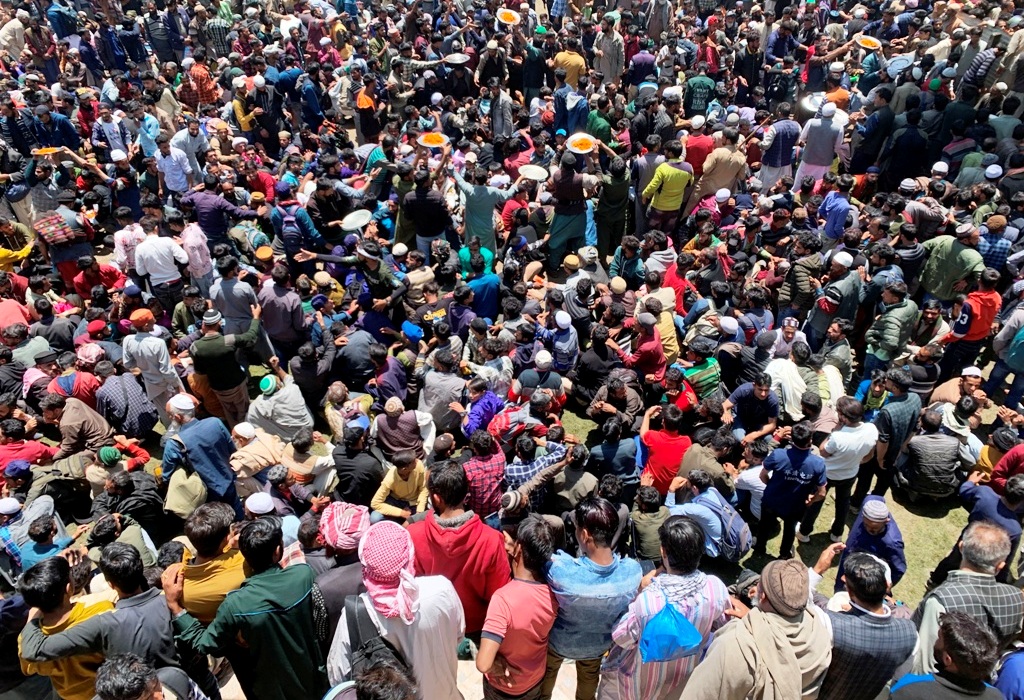Even the landslides on Mughal Road prevented a lot of people from joining the Urs, Wangat remained too crowded during the 3-day festival, reports Syed Shadab Ali Gillani
After Covid19 lockdown and the demise of Mian Bashiruddin, Wangat hosted the massive annual congregation at Baba Nagri. Tens of thousands of people ensure their attendance at the annual Urs of Hazrat Nizamuddin Kiyanawi, the most respected spiritual leader of Gujjars, has a following on both sides of the political divide.
For them, June 8, is a huge festival as thousMian Altrands of people from Poonch, Rajouri, Kupwara, Bandipora, Shopian, Kathua and other parts of Jammu and Kashmir, as well as other states, ascend to the spot of the shrine.
25 Visits
Haji Abdul Rashid from Kalakote (Rajouri) has never missed the Urs in the last 25 years. ” This year I believe there are around 10,000 more people than last year,” Haji said. “People across Jammu and Kashmir and even from outside come here. Earlier people used to visit from Pakistan, too.”
The net difference, Rashid said, is that earlier people used to foot the distance and now they travel in huge caravans of cars. “We usually come in small groups. This year due to the uncertain condition of the Mughal Road we travelled via Jammu.”
A Business Corner
Located amidst the dense forests on foothills overlooking the Sindh River, there were only people cars, buses and motorcycles visible. With devotees making a lot of charity, the festival has an impressive corner for business too.

“These three days are a blessing for us,” Umair Ahmed, a street vendor from Kangan, said. Is selling footwear since 2017. “We did a good sale and are hopeful to end on a good note. This is a big festival for people and by the grace of Allah we also get benefit out of this,” he said.
Most of the young people were seen purchasing clothing and the routine jewellery that the womenfolk use.
Fascinating Location
The shrine and adjacent streets were packed with men, women and children playing here and there.
The Baba Nagri shrine owes its genesis to the late nineteenth century when Hazrat Baba Jee Sahib Larwi, the ancestor of the Mian family moved to Pakistan’s Khyber Pakhtunkhwa province’s Hazara from Kashmir to meet his mentor, Hazrat Nizam-ud-Din Wali Kiyanawi. There, he was asked to go home and spread Islam.
Mohammad Yousuf Baniya, 63, a resident of Dard-Wudar village said the Baba Ji’s actual name was Hazrat Mian Abdullah Sahab.
Author of various Islamic books, including Asrar-e-Kabaree and Malfoozat-e-Nizame on Fiqah and Tasawuf, Baba Ji was succeeded by his son, Mian NizamudDin and later Mian Bashiruddin, his son, took over. Mian Altaf was nominated as his spiritual heir by him.
Imtiaz is a Shopian teenager. This was his third visit to the shrine. “Earlier I did not understand anything but this year I got the idea of what this Urs is all about,” Imtiaz said. “My parents taught me about this and this time I even understood what the Molvi Sahab was preaching.”
The Custodians
The Mian family is the custodian of the shrine and Mian Altaf Ahmad, the great-grandson of Baba Jee is the present Sajjada Nasheen, the caretaker of the shrine. A senior National Conference leader, Mian Altaf is the most respectable and revered figure in the Gujjar community.
“Everything here is done in accordance with the Shariah,” Mian told reporters on the sidelines of the festival. “This Urs is something our family has been doing for a long now. We always try to accommodate as many devotees as we can and cater to all of their needs.” For all three days, the host family ensures the lodging of the devotees. The shrine has a round-the-clock Langhar (community kitchen) and enough space to make the devotees feel at home.

For Choudhary Marshad Ali Wangat visit is spiritual healing. “It is a bond of Peer and Murshid (Mentor and disciple) and the Mian family is our Peer and we have deep respect and regard for each and every member of the family,” Ali said.
“Mian Sahab always talks about brotherhood and unity among people, his message is very clear and he always wants people to stay united, peaceful and spread love.”
Donations for Shrine
In respect for their leaders, the devotees make donations in cash and kind that keep the Langhar hearth going. Though the Urs is the main time for the visit, people come on other occasions too. Some people visit the shrine during the harvesting season and from 2021 people visit in August for the death anniversary of Mian Bashiruddin as well. People who participated in the festival said the numbers would have been more having the Mughal Road not suffered the landslide that restricted the movement of bigger vehicles.
Interestingly, some of the herdsmen who move their flocks from Rajouri and Poonch early in the season pitch their tents closer to the shrine area so that they remain in close proximity to their religious leader.















